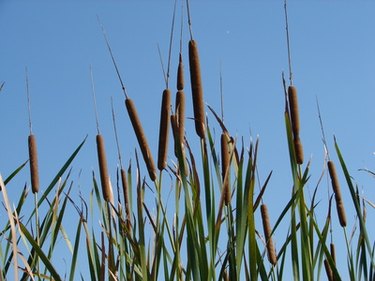
Tennessee is home to a vast selection of geological regions, from high mountain peaks to low river floodplains. The diversity of the Tennessee landscape has enabled a number of different plant species to grow and thrive in the area. Many of the wild plants that grow across the state of Tennessee are edible, providing healthy nutrients to the body for survivalists, outdoorsmen or simply those who enjoy living off the land.
Cattails
Video of the Day
Cattails are tall, grass-like plants that grow close to water. They can be found near rivers, lakes and streams, or even in roadside ditches where water often accumulates. Cattails are best recognized for their long, furry shaft that tops the plant stem. Young cattail shoots can be eaten raw or cooked. If the shoot is still green, it can be boiled and consumed like corn on the cob. Mature cattails can be pounded on a hard surface to remove the inner rhizome and used as flour, according to Wilderness-survival.net.
Video of the Day
Chicory
Chicory plants are often considered a nuisance weed in North America, but this strong-tasting plant is really quite beneficial to have around. All parts of the chicory plant are edible. Chicory roots can be cooked like most vegetables and the leaves can be eaten cooked or raw. Roasted chicory roots can be ground into a powder and used as a coffee substitute or additive, as recommended at Survivaliq.com.
Dandelion
Dandelion plants are also considered a weed, but these flowering plants are rich in nutrients--including vitamins A and C--as well as calcium. All parts of the dandelion plant can be consumed, according to Wilderness-survival.net. Roots of the plant can be boiled and eaten, or roasted and ground into a powder for use as a coffee substitute. Dandelion leaves can be eaten raw, boiled or fried.
Nettle
Nettle plants are highly nutritious, but you must take care when harvesting and preparing them for consumption. Nettle plants are coated with fine bristles that contain irritant chemicals that cover all surfaces of the plant. When touched, these bristles can cause mild to severe stinging sensations on the skin, according to the University of Maryland Medical Center. The chemicals contained in the nettle plant are powerful enough to irritate the skin even through protective clothing, which makes harvesting the plant difficult.
The nutrition value of the plant however, along with its widespread availability, makes nettle plants a valuable source of food in the wild. Once the plant is safely harvested, boil the leaves and stems of the plant to destroy the stinging chemicals contained within, making it suitable for consumption.
Plantain, Broad- and Narrow-Leaf
Broad- and narrow-leaf plantains are common weeds that can be found in almost every region of North American, including Tennessee. The plantain is a hardy and evasive plant that grows along roadsides and in grassy areas. Young leaves of the plant can be eaten raw, but mature leaves should be boiled before consumption, according to Survivaliq.com. The plantain seeds can be eaten raw or toasted for a tasty, nutritious treat.